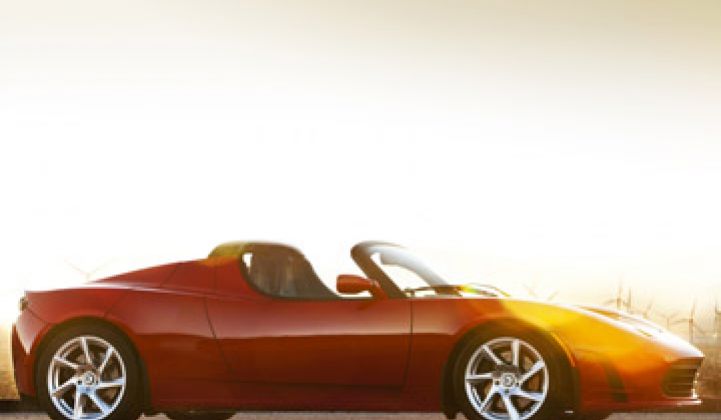The automotive press and the first few Tesla sedan owners are raving about the quality and performance of the Tesla Model S sedan. Frank Markus of Motor Trend wrote, "The Model S bolts away from a stop like any EV, but it accelerates from 60 to 80 mph like a big gasser, continuing to pull strongly past 100 mph.” (Our high-speed test is here.)
Tesla (Nasdaq:TSLA) shareholders won't be experiencing the same immediate thrill. Tesla's revenue fell to $27 million in the second quarter, down from $30.2 million in the first quarter, and $58 million in the second quarter of 2011. Net loss for the quarter was $106 million, up from $90 million in Q2 2011. The fall in revenue was due to the diminishing deliveries of the limited edition two-seater roadster. But these financials are largely irrelevant, as it's the next few quarters which will prove Tesla's manufacturing mettle, ability to scale, and ability to reduce cost.

As Lindsay Riddell of the San Francisco Business Times reports, "It's expensive to build a car company from scratch." In the most recent quarter, Tesla spent $75 million on R&D, $36 million for operations, and $68 million to build out its network of showrooms and service centers. The company is investing immense resources into sales, service, and customer relations -- there's no underestimating good customer service in this kind of business.
Tesla has more than 12,000 folks who have put down payments on its move to the big time -- the Model S sedan. Tesla says it is on track to build 20,000 sedans in 2013, although only 40 have been built and ten delivered so far.
According to Barclays, "Improved visibility on [Tesla's] ability to meet multiple key metrics in the near term should support further share improvement. We continue to believe that Tesla has the tools and team in place to do so. However, we recognize that until the metrics are in fact delivered, skeptics (of which there are many given its short interest) are unlikely to reverse their position."
Tesla's 2012 guidance aims for revenues of $560 million to $600 million in 2012 and Model S volumes of 5,000 units this year. It is the fourth quarter in which Tesla has to rev the factory engine, as only 500 units are targeted for the third quarter. Tesla looks to ship 20,000 sedans in 2013 at a gross margin better than 25 percent, according to CEO Elon Musk.
Other notes:
- Telsa is entering a partnership with Wells Fargo to provide retail financing for customers in the U.S.
- The sedan won a record number of retail reservations in June.
- Tesla "made good progress in the development of the full electric powertrain for the Mercedes Benz EV," resulting in development services revenue.
- Overall gross margin for Q2 was 18 percent, "driven by strong development services margin."
- The company has $266 million in cash -- $233 million in total cash on hand, including its Department of Energy (DOE) dedicated accounts, and an additional $33 million left to draw on its loan facility with the DOE. Tesla drew down $71 million from its DOE loan facility in Q2 and looks to draw all remaining funds in the next few months.
- Tesla said it expects to be "close to free cash flow breakeven in Q4 of this year."
In summary: a striking new automotive design from a company funded by Silicon Valley venture capitalists and DOE loan guarantees helmed by a rockstar CEO who has actually delivered on many of his promises. But it's now crunch time, and the firm needs to execute close to flawlessly over the next six quarters to prove its claims and to keep the market interested in its stock. And that means delivering 25,000 sedans.
***
We recently ran a perspective piece on Tesla and electric vehicles in which John Petersen suggested that "a grid-powered electric vehicle might make individual drivers feel warm and fuzzy about themselves, but from a public policy and resource-conservation perspective, it’s the most wasteful plan ever devised." We had a rebuttal from NRDC attorney Max Baumhefner. Nick Butcher took a close look at whether there is a battery material resource limitation to widespread electric vehicle penetration in Part One of his EV investigation. In Part Two, he looks at whether EVs are really ‘clean and green,’ or are just misrepresented as such.



